Hallowed Grounds Race, Slavery, and the University of Alabama
Based on original archival and secondary research, this alternate campus tour hopes to shed light onto the lives, experiences, and legacy of the many unsung men, women, and children who lived, worked, and even died at the University of Alabama.
From the construction of the initial buildings to the destruction of the campus on April 4, 1865, enslaved people performed much of the labor at the University of Alabama.
They served on construction crews for all university buildings, maintained the grounds and facilities, cooked, laundered, performed janitorial duties and did other assorted tasks essential to the operations of the institution. Several even assisted the faculty in their pathbreaking research.
Viewed as property either owned or leased by the university, they suffered the abuses of students and faculty. Some resisted. Some were punished.
The majority established communities among the other enslaved laborers in order to cope.
Overall, enslaved men, women, and children labored, survived to the best of their abilities, and helped to build the campus.
Indeed, these are hallowed grounds that current students, faculty, staff, and guests walk upon daily.

Gorgas House
As the first building on campus, enslaved people worked on its construction as well as all other buildings later erected on this campus. According to two university historical chroniclers, Ben was the first enslaved person purchased by trustees. He worked under the direction of the architect, did landscaping, and maintained fencing before being sold shortly after the University opened.
While functioning as the Campus Dining Hall, enslaved people prepared food in a two-story brick kitchen where Morgan Hall currently existed (yellow building in background), transported meals and water, and served students therein. Moses and other enslaved workers routinely dealt with rowdy students as they served and cleaned up after the rowdy students until administration converted the building to the Steward's House.
After the conversion, university owned men and other hired-out enslaved individuals continued to work in the building up until the destruction of the campus. Currently, it serves as a museum dedicated to the life and work of the Gorgas family, with particular emphasis on Amelia Gayle Gorgas.
Morgan Hall
Prior to the construction of the current building, a two-story brick kitchen that prepared food for the Campus Dining Hall was located here. Enslaved men and women prepared the food. Enslaved men, women, and children carried buckets of water to the building and then moved food to the dining hall.
John Tyler Morgan, the building namesake, was a former Confederate general who worked to extend Jim Crow segregation across the nation, advocated for the forced African American migration, and rose to leadership in the Montgomery chapter of the Ku Klux Klan.
Morgan's portrait hung in the foyer until late Fall 2015. Students, faculty, staff, and visitors are now greeted by a piece art from the university's Paul R. Jones Collection of American Art.
"Cassandra" by Benjamin Smith invites individuals to reflect of Morgan's legacy, slavery, and race relations more broadly.
Little Round House/Guard House
Built in 1862, this building provided shelter to student cadets on sentry duty during inclement weather. More importantly, It served as the headquarters for the Drum Corps, which consisted of rented slaves.
Neal, Gabe and Crawford assisted with cadet drilling and provided music for events on campus and in the Tuscaloosa community. After replacing Neal in 1864, Crawford and Gabe performed their "duty" and alerted cadets when federal forces approached the university in the early morning of April 3, 1865.
It is one of the few surviving antebellum structures with a historical marker acknowledging both slavery and the contributions of enslaved people to the institution. This was not always the case.
The Little Round House embodied a particular Lost Cause narrative of the Civil War and justification of racial subordination during the Reconstruction and Jim Crow segregation eras. In commemoration of the centennial anniversary of the Civil War, students chose an image of the structure with both Confederate and United States flags flying above it. Hence, students transformed the structure into a symbol of the massive white resistance to desegregation.
As of October 2016, this slave cabin became a no tailgate area during Alabama home football games. It is now elevated to a similar status given to the Mound and other sites of memory deemed as sacred.
Franklin Hall (built in 1833) was one of the buildings destroyed by federal forces on April 4, 1865. Unsalvageable bricks were placed in the memorial to the antebellum campus, slavery, and Confederate defeat.
Enslaved servants worked in all of the dormitories (barracks, 1861-1865). The enslaved men who served the students of Franklin Hall often slept where it was possible in the stairwell, hallway, and even on the surviving front stoop.
Presidents' Mansion
Built in 1838, both Presidents Manly and Garland employed their own slaves in the Presidents’ Mansion. They also rented out others for service at the mansion, especially when entertaining. The men, women, and children who worked at the mansion often had a higher quality of clothing and shoes. Embodying the reputation of the school, they looked the part.
The four original outbuildings remain. Two outer buildings (one shown) were originally used as the quarters for the Presidents' personal slaves. The one closest to the mansion was employed as the kitchen. The other contained the well and was used as a washroom.
During the events leading up to the destruction of the campus, President Garland employed enslaved cooks and servants to gather necessary food and supplies for the retreat from Tuscaloosa to Marion, Alabama. According to university lore, Mrs. Garland and one of her enslaved servant prevented its destruction. However, most enslaved campus laborers welcomed the "Yankee invaders."
Constructed in the early 1920s, it is named after Josiah C. Nott, a physician and racial theorist from Mobile, Alabama, who is one of the founders of the Medical School in Mobile. He is more known for racial theory works, including the Types of Mankind . In this 1854 publication, Nott espoused a belief in polygenesis (multiple and separate evolutionary origins) as a justification for slavery, racial subordination, and white supremacy.
After the Civil War and emancipation, Nott did not change his views on African Americans. He felt that they as well as other inferior races lacked the capacity to learn and would remain intellectually deficient.
In recent years, the namesakes of Nott and Morgan Hall has raised questions of what to do with these buildings. Does the institution rename them? Add new revised plaques and markers? Name new buildings in order to bring balance? But the question remains - what to do this racial past?
Nott and Morgan Halls are not the only buildings with contested namesakes. From the construction of Woods Quad to Nott Hall, each post-emancipation building is named after individuals connected to slavery, the Civil War, postwar politics of exclusion, and/or violence.
Presidents Woods, Manly, and Garland oversaw the institution of slavery. Faculty Tuomey, Barnard, and Smith used enslaved labor on campus in their teaching and research. From the university's long history, there are examples of possible solutions.
This is neither the original location nor design of the United Daughters of the Confederacy Boulder. It has been moved and reinterpreted in its current location.
Originally located in the Rotunda Plaza, the monument was placed on a small mound and featured a brick enclosure.
Dedicated in 1925, the United Daughters of the Confederacy Memorial Window was moved from the first Amelia Gayle Gorgas library (now Carmichael Hall) to the renovated Gorgas Library and finally to W. S. Hoole Special Collections in Mary Harmon Bryant Hall. Designed by Tiffany Studios of New York, each move reflects a reinterpretation.
Initially placed in the Amelia Gayle Gorgas Library's lobby in Fall 2015, the concerns and complaints of students, faculty, staff, and alumni over the casual depictions of slavery in this large oil painting caused its removal in late summer 2016.
On the other hand, audiences celebrated Freedom and Fire , an opera commemorating the last days of the Civil War and the campus's destruction. Robin Behn, acclaimed poet and English professor in The University of Alabama College of Arts and Sciences, included two scenes recognizing the contributions of enslaved people.
Scene III featured a musician observing sleeping sentry duties at the Guardhouse. Audiences heartily applaused Scene VII in which Mrs. Garland and her enslaved female servant gave different pleas for saving the Mansion from destruction by federal soldiers.
But more importantly, the University can look to the slave cemetery and its history surrounding the apology marker.
Before most other institutions nationally, the University of Alabama formally apologized for owning and using enslaved laborers. Spearheaded by Al Brophy and other faculty, they approached and secured the apology from the Faculty Senate in 2004.
As a leader in this national discussion, the University erected an apology marker. Since 2004, conversations on how to deal the institution's racial past with slavery and race more broadly. Education, lectures, alternate tours, and other efforts at sustained dialogue remain essential.
Lest we forget the names of the enslaved men, women, and children who labored at the University of Alabama and helped to make it into the present diverse and inclusive campus of today.
About the Creator: Dr. Hilary N. Green is an Assistant Professor of History in the Department of Gender and Race Studies at the University of Alabama. She earned her M.A. in History from Tufts University in 2003, and Ph.D. in History from the University of North Carolina at Chapel Hill in 2010. Her research and teaching interests include the intersections of race, class, and gender in African American history, the American Civil War, Reconstruction, Civil War Memory, and the Black Atlantic. She is the author of Educational Reconstruction: African American Schools in the Urban South, 1865-1890 (Fordham University Press, 2016). She is currently developing a book manuscript that explores how everyday African Americans remembered and commemorated the Civil War from its wartime origins to the present.
Suggested Readings
The Corolla , Acumen, University of Alabama Libraries’ Digital Archives
RG 1 – University of Alabama Early Administrative Records, Acumen, University of Alabama Libraries’ Digital Archives, acumen.lib.ua.edu.
Alfred L. Brophy, University, Court, and Slave: Pro-slavery Thought in Southern Colleges and Courts and the Coming of Civil War (New York: Oxford University Press, 2016).
James B. Sellers, History of the University of Alabama. Volume I: 1818-1902 (Tuscaloosa: University of Alabama Press, 1953).
Contemporary photos were taken by the author.
Your report has been submitted.
There was a problem submitting your report. Please contact Adobe Support .
Report Abuse
If you feel that this video content violates the Adobe Terms of Use , you may report this content by filling out this quick form.
- Trademark Infringement
- Offensive Content
- Racist or Hate Content
- Sexually Explicit Content
- Please provide a description of your concern.
To report a Copyright Violation, please follow Section 17 in the Terms of Use .

The Crimson White
- TOP STORIES
Hallowed Grounds displays history of slavery
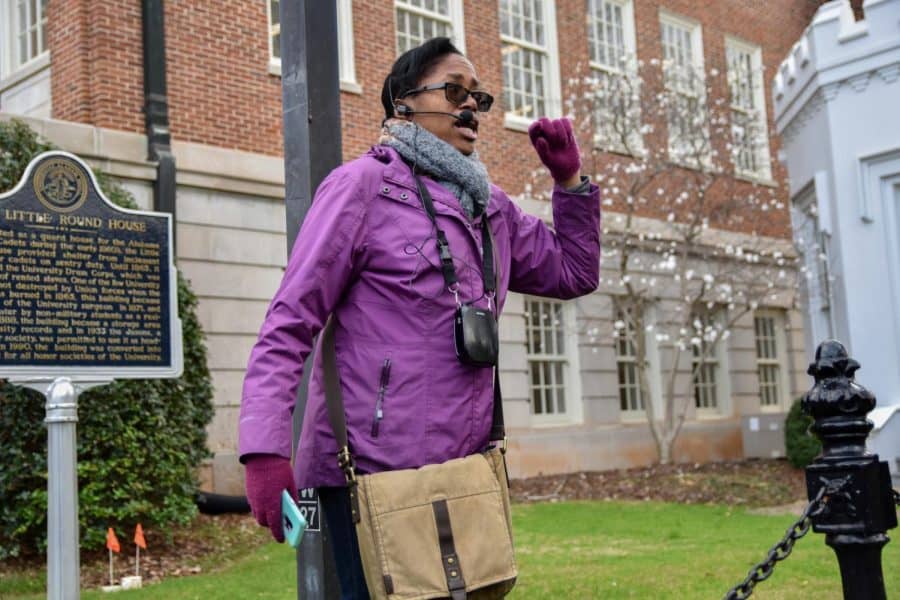
Jessa Reid Bolling , Assistant News Editor February 21, 2019
During the week, thousands of students scurry across campus going about their daily routines, seemingly unaware of the history that lies beneath their feet.
One professor has been unearthing that history and honoring those who suffered under the institution of slavery at The University of Alabama.
Shortly after Hilary Green, associate professor of history in the Department of Gender and Race Studies, began teaching at the University five years ago, she encountered a student who said slavery had never existed at the University.
“I immediately thought, ‘Okay, I’ve got to do something about this,’” Green said. “I tried to formulate a walking tour across campus but also a lecture within my courses that I would regularly teach. So, the following August, we walked the campus.”
For the past four years, Green has been guiding hundreds of visitors along a one-hour walking tour called the “Hallowed Grounds Tour,” shedding light on the experiences of enslaved people owned by the University during the 1800s.
Green’s research led her to documents from 1831 to 1865, such as bills of sale for slaves purchased by the University, student tuition bills that listed “servants” as one of the tuition fees, documents of enslaved people that received medical treatment and the diary of former UA President Basil Manly that documented the names of many enslaved people owned by the University.
From the original construction of the University until it’s destruction on April 4, 1865 by Union troops, slaves were both bought and used for much of the labor at the University. They were made to maintain the grounds, clean, cook and perform other tasks to tend to the students and the campus.
The tour begins at Gorgas House and makes stops at the Little Round House, The Mound, the President’s Mansion, Smith Hall and the slave cemetery. Tour dates can be scheduled online with a maximum of 20 people per tour group.
Along the tour, Green described the way slaves had to live, serving and cleaning up after students, carrying buckets of water from Marrs Spring to various buildings, sleeping on floors or on stoops of the dormitories they tended to as they were forbidden from sleeping in any of the rooms – some slaves even giving birth on school grounds.
During the tour, Green called out the names she found of some of the slaves who were owned by the University and asked the tourists to say their names out loud, ensuring that the names of enslaved people like Ben, Moses, Isaac, William, Neal, Crawford, Gabe, Arthur, Sabra and Lydia will be remembered by future generations.
“We represent that long legacy because we are the UA community,” Green said. “From slavery to our present diversity, we are always being informed and shaped by that past, but that doesn’t mean it will hinder our future.”
The tour ended at the slave cemetery near the Biology Building, where two University-owned slaves, Jack Rudolph and William “Boysey” Brown, and a student are buried. In 2006, a historic marker was installed near the graves, recognizing their burial and commemorating the UA Faculty Senate’s apology in 2004 for their predecessors’ role in the institution of slavery.
“One of the things that we can be proud of is that UA was a leader in having these difficult conversations and acknowledging these places as sacred sites,” Green said. “We are the first in the SEC to do this. Other schools are following us.”
Gloria McClendon, a junior majoring in African American studies, said the tour was eye opening for her, and that learning of the history of slavery on campus will give her a different perspective when walking around campus.
“Having insight on that part of the history on this campus means a lot,” McClendon said. “I was just happy to dig deeper, especially with my major, into the history of our campus itself.”
Vashton Smith, a freshman majoring in history, said learning about the University’s past with slavery adds another layer of understanding to the experiences of African-Americans on campus, including the civil rights events that would later take place here.
“It really served to illustrate how oppressed African-Americans were at a time in this school’s history and in this country where the cultural differences between blacks and whites on a southern college campus had the blacks as the help and even in some cases the sexual objects of the masters,” Smith said. “It just showed me how the racism of that time really permeated throughout the state, and how we need to keep educating people on these topics.”
By going on the tour, Green said visitors can have a greater appreciation of how far the University has come from its past with slavery to its current racially diverse campus.
“The University, in all of its complexity, has a complex past with race and memory of the African-American experience that predates the opening of the school,” Green said. “It’s not a shameful past but one that continues to inform the University. So by walking the tour and learning about the enslaved people, you’re also learning about another under-appreciated and often untold story about the school too.”

City Council and UA fund utilities improvements with joint agreement

UA professor pleads not guilty to possession of content depicting sexual abuse of minors

Residents demand action after trespassing at Lark in the Woods

UA researcher leads team of students through international research study

Students push for more reusable utensils

Tuscaloosa sewage carries bacteria and threatens biodiversity

Police chase through campus results in damage to several cars
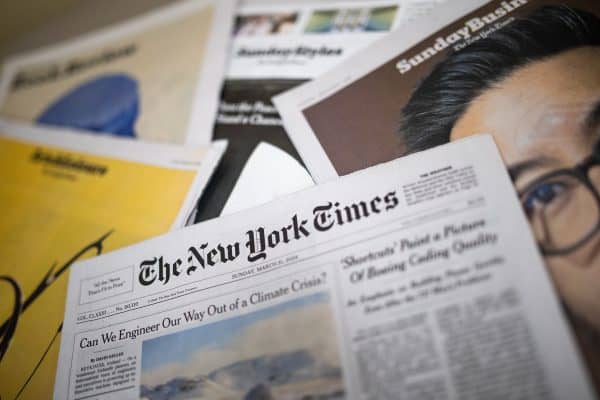
UA Libraries offers free access to New York Times for students, faculty and staff
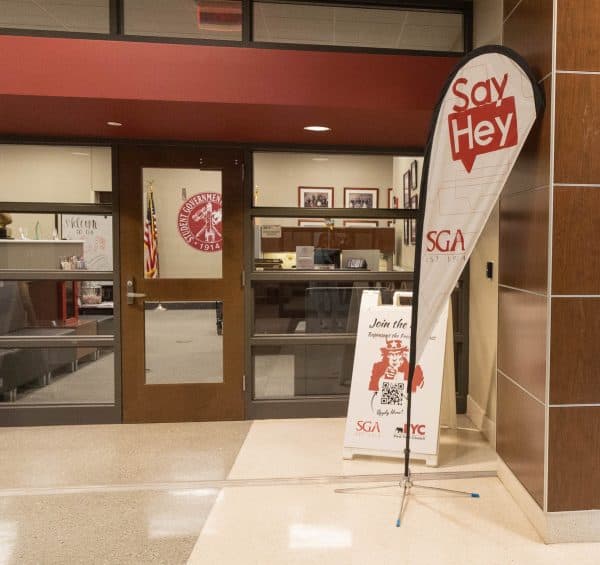
SGA confirms executive secretary, chief of staff
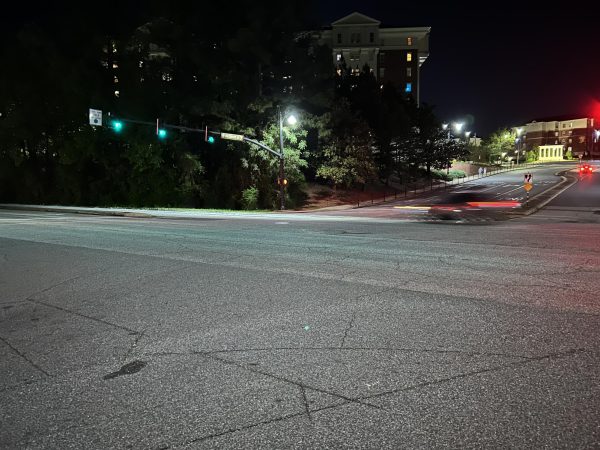
Alabama football player faces lawsuit after alleged hit-and-run
- Preplanned tours
- Daytrips out of Moscow
- Themed tours
- Customized tours
- St. Petersburg
Moscow Metro
The Moscow Metro Tour is included in most guided tours’ itineraries. Opened in 1935, under Stalin’s regime, the metro was not only meant to solve transport problems, but also was hailed as “a people’s palace”. Every station you will see during your Moscow metro tour looks like a palace room. There are bright paintings, mosaics, stained glass, bronze statues… Our Moscow metro tour includes the most impressive stations best architects and designers worked at - Ploshchad Revolutsii, Mayakovskaya, Komsomolskaya, Kievskaya, Novoslobodskaya and some others.
What is the kremlin in russia?
The guide will not only help you navigate the metro, but will also provide you with fascinating background tales for the images you see and a history of each station.
And there some stories to be told during the Moscow metro tour! The deepest station - Park Pobedy - is 84 metres under the ground with the world longest escalator of 140 meters. Parts of the so-called Metro-2, a secret strategic system of underground tunnels, was used for its construction.
During the Second World War the metro itself became a strategic asset: it was turned into the city's biggest bomb-shelter and one of the stations even became a library. 217 children were born here in 1941-1942! The metro is the most effective means of transport in the capital.
There are almost 200 stations 196 at the moment and trains run every 90 seconds! The guide of your Moscow metro tour can explain to you how to buy tickets and find your way if you plan to get around by yourself.
Home Page › Our tours › Moscow tours
- Our Service
- Our Photo Album

Moscow tours
We take part in bbc series of documentaries "world's busiest cities"(moscow).

Buy Tickets to the Bolshoi Theatre

Other special offers...
Interpreting and assistance at exhibitions and conferences, our garage ( vehicles+drivers), where to stay in moscow, what and where to eat in moscow, visa support, learning and discovery, our partners (trips to st.petersburg).
Copyright 2015 - Moscow Navigator

- About Marina Wilson Private Tours
- TripAdvisor Forum
- Meet Marina Wilson
Private Tours
- Tailor-made Tour Packages of St Petersburg & Moscow
- Moscow Day Tours
- St Petersburg Small Group Tours
- Combo Tours St Petersburg
- Walking Tours in Moscow & St Petersburg
- Winter Tours in St Petersburg
- Private Shore Tours
- Group Shore Tours
- Yekaterinburg Tour
- Sergiev Posad Tour
- Local Cooking Classes
- Ballet and Folk Show Tickets in St Petersburg and Moscow
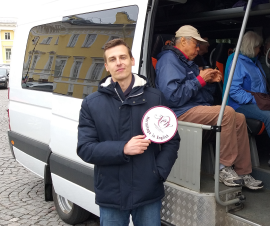
Tour of Kremlin Grounds
- Adults $ 105.00
- Children $ 95.00
Tour Duration: 2 hours
Departures are guaranteed
Meet the guide at 13:30 near the Kutafia Tower
Inclusions: licensed tour guide service, pre-booked admissions to the Kremlin. This is ‘Skip-the-Line ‘ tour. The tourists meet their guide at the entrance to the Kremlin, the Kutafya Tower at 13:30. If you request transportation from your hotel to the Kremlin, please contact us through the Contact page.
Kremlin is the heart of Moscow, it has always been associated with the Russian government. The Kremlin towers witnessed a lot of dramatic events which took place within its walls. There were assassinations, sieges, murders, insurrections along with religious rituals and victory parades. The word Kreml means a fortress, and the very first fortress was wooden. The first foundation dates back to 1156. Its importance increased when Moscow princes acquired it. Besides, the Russian Church received the residence there in 1320s. In the XV century Italian engineers started their work on a small town in Moscow and the Kremlin gradually got its view the way we know it now. Though Peter I preferred Saint Petersburg and made it the capital city in 1712, many events of state importance such as coronations still took place in Moscow. The Kremlin also became the government seat of the Bolsheviks in 1918.
During the Kremlin tour, you will get a deeper insight into the history of the place.
The Kremlin tour includes a tour of 3 cathedrals situated inside the walls of the Kremlin . First, the Cathedral of Archangel Michael (Arkhangelsky). The Italian architect, Alevisio Novi, built it in the XVI century. The works began in 1505 and continued till 1508. He managed to unite the traditional architecture of Russia with the elements characteristic of the Italian Renaissance. The Kremlin also has the burial places of tsars and princes of Muscovy (except Boris Godunov) beginning from the XIV to the XVIII century. They are located in the Archangel Michael Cathedral.
The Cathedral of Annunciation (Blagoveshchensky) was a place of worship for tsars and the royal family. The wedding ceremonies and christenings took place there too. The team of Pskov masters constructed it at the end of the XV century. There are many works of art in the Cathedral of the Annunciation in the Kremlin including old frescoes that date back to 1508, made by Theodosius. The iconostasis has works created by Theophanes the Greek, Master Andrey Rublev, Prokhor of Gorodets.
The next Cathedral to visit during the Kremlin tour is the Uspensky Cathedral or the Assumption Cathedral. It is a masterpiece of the Italian architect Aristotel Fioravanti. The construction continued for 4 years. The Uspensky Cathedral is known as the coronation cathedral since 1551, when the Throne of Monomakh was brought in here. Patriarchs and metropolitan bishops of the Orthodox Church were buried there too.
During the Kremlin tour, visitors can see the Patriarch’s Palace (no inside visit) which was turned into a Museum of the XVII century life and Applied Art. The construction of the Palace began in 1640. The Palace joins the Church of Twelve Apostles, used as a home church for patriarchs. The Palace reminds about the Patriarch Nikon who was a reformer.
Kremlin tour is available any day except Thursday in five languages: English, German, French, Spanish, Italian . The groups are maximum 8 PAX and departures are guaranteed. The tour starts at 13:30 near the Kutafia Tower (the guide will hold a company logo or your name sign) and lasts for 2 hours.
Please note that Kremlin is a very busy museum and tour time changes are possible due to museum availability. As much as possible we try to avoid such situations.
The Kutafia Tower(white)

Certificates of Excellence

Sign up to our newsletter
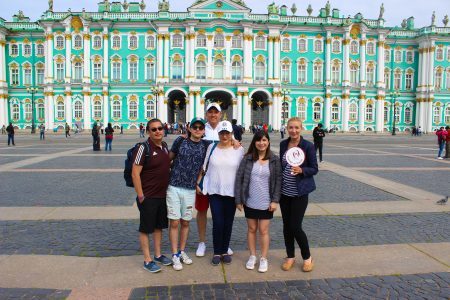
Request call
2018 Primetime Emmy & James Beard Award Winner
R&K Insider
Join our newsletter to get exclusives on where our correspondents travel, what they eat, where they stay. Free to sign up.
A History of Moscow in 13 Dishes
Featured city guides.

IMAGES
VIDEO
COMMENTS
The BFSA Ambassadors have partnered with Dr. Hilary Green to give the Hallowed Grounds Tour. This tour is a by product of Dr. Green's research on the history of slavery at the University of Alabama. The tour is open to current students, alumni, faculty, staff, community members and potential students. The tour will take approximately 45 minutes ...
BFSAA is proud to host The Hallowed Grounds Tour, a walkthrough of campus that delves into black history and the civil rights movement on campus. This tour is a product of Dr. Green's research on the history of slavery at the University of Alabama. The tour is open to current students, alumni, faculty, staff, community members and potential students. The tour will take approximately 45 minutes ...
For Fall 2022, tours are led every Wednesday at 3:15 PM. Our first tour will be Sept. 21. Please meet by the historic marker in front of the Gorgas House Museum (810 Capstone Dr., Tuscaloosa AL 35401). Participants are encouraged to dress for outdoor walking and bring water. In case of inclement weather, indoor virtual tours will be held at the ...
Description. BFSAA is proud to host The Hallowed Grounds Tour, a walkthrough of campus that delves into black history and the civil rights movement on campus. This tour is a product of Dr. Green's research on the history of slavery at the University of Alabama. The tour is open to current students, alumni, faculty, staff, community members and ...
BFSAA is proud to host The Hallowed Grounds Tour, a walkthrough of campus that delves into black history and the civil rights movement on campus. This tour is a product of Dr. Green's research on the history of slavery at the University of Alabama. The tour is open to current students, alumni, faculty, staff, community members and potential ...
CW x 1956 Magazine. "Hallowed Grounds" tour highlights UA's history of slavery and racism. CW / David Gray. Augustus Barnette and Andrea Tinker October 20, 2022. Among buildings named after Ku Klux Klan members and sorority racism scandals, The University of Alabama is often under a microscope when it comes to racial issues.
The BFSA Ambassadors have partnered with Dr. Hilary Green to give the Hallowed Grounds Tour. This tour is a by product of Dr. Green's research on the history of slavery at the University of Alabama. The tour is open to current students, alumni, faculty, staff, community members, and potential students. The tour will take approximately 45 minutes to complete.
Advance registration is required! Please RSVP on MySource! Join the BFSA Ambassadors for the Hallowed Grounds Tour! The tour will last approx 35 mins. The tour will begin at the Gorgas House. Attendance will be worth 3 SGA DEI Passport Points! Advance registration is required! Please RSVP on MySource!, powered by Localist, the Community Event Platform
Hallowed Grounds Tour. September 21, 2022 @ 3:15 pm - 4:00 pm. Labor Day - UA Closed. Registration for Spring 2023 Begins. Hallowed Grounds campus tours, which highlight the history and legacy of slavery at the University of Alabama, are based on the archival research of Dr. Hilary Green. Led by current graduate students and faculty in the ...
Hallowed Grounds Tour x OneUA Week. Date and Time. Thursday, February 8 2024 at 10:00 AM CST to . Thursday, February 8 2024 at 11:00 AM CST. Add To Google Calendar ... The tour will last approx 35 mins. The tour will begin at the Gorgas House. Attendance will be worth 3 SGA DEI Passport Points! Advance registration is required! Please RSVP on ...
This tour showcases the names of the enslaved, the surviving spaces where they labored, their connections to buildings named after individuals who upheld the institution, and hopefully shed light on their campus experiences. In addition to sites of slavery, several tour stops explore this legacy for the present-day campus community. Tour Stops
The Department of Gender and Race Studies and Black Faculty and Staff Association Ambassadors have collaborated since 2015 to run the Hallowed Grounds tours. These tours aim to educate students and community members about the University's long history of slavery and how it connects to existing campus structures. JaiOnna Terry, a graduate student in the...
Hallowed Grounds campus tours, which highlight the history and legacy of slavery at The University of Alabama, are based on the archival research of Dr. Hilary Green. Led by current graduate students and faculty in the Department of Gender and Race Studies, tours are free and open to the public and last approximately 45 minutes. Tours for ...
Hallowed Grounds Race, Slavery, and the University of Alabama Based on original archival and secondary research, this alternate campus tour hopes to shed light onto the lives, experiences, and legacy of the many unsung men, women, and children who lived, worked, and even died at the University of Alabama.
A UA professor created a walking tour to commemorate the lives of enslaved people owned by The University of Alabama in the 1800s and to educate visitors on the University's racial past. ... Green has been guiding hundreds of visitors along a one-hour walking tour called the "Hallowed Grounds Tour," shedding light on the experiences of ...
Known for her "Hallowed Grounds" tour, which takes visitors on a tour of the University while discussing the evolution of campus, Green's historical research is unparalleled. ... The tour focuses on the deep-rooted history of UA, including the lives and experiences of many enslaved humans. Green has published several books, journal ...
Hallowed Grounds Tour: Take a trip around UA's campus to visit historical sites related to race, slavery, and progress at UA since opening in 1831. President's Mansion Tour: See the behind the scenes of the President's Mansion and take some time for a guided walk around classes to find your classes.
The Moscow Metro Tour is included in most guided tours' itineraries. Opened in 1935, under Stalin's regime, the metro was not only meant to solve transport problems, but also was hailed as "a people's palace". ... Park Pobedy - is 84 metres under the ground with the world longest escalator of 140 meters. Parts of the so-called Metro-2 ...
Moscow in 3 days. Tour price: 550 USD. Tour duration: 3 days (24 hours) Additional expanses: Entrance tickets to the museums. Day I. On the first day you will take a driving tour of the city. Then we suggest a short break for lunch and a visit to the Tretyakov art gallery, the biggest museum of the national Russian art.
Hallowed Grounds Tour x OneUA Week. Date and Time. Tuesday, February 6 2024 at 2:00 PM CST to . Tuesday, February 6 2024 at 3:00 PM CST. Add To Google Calendar ... The tour will last approx 35 mins. The tour will begin at the Gorgas House. Attendance will be worth 3 SGA DEI Passport Points! Advance registration is required! Please RSVP on ...
Tour of Kremlin Grounds. Adults $ 105.00; Children $ 95.00; Book now. Tour Duration: 2 hours. Departures are guaranteed. Meet the guide at 13:30 near the Kutafia Tower. Inclusions: licensed tour guide service, pre-booked admissions to the Kremlin. This is 'Skip-the-Line ' tour. The tourists meet their guide at the entrance to the Kremlin ...
This tour takes you from one of Moscow's oldest streets to its newest park, hitting the Kremlin, some illustrious shopping centers, architectural curiosities, and some of the city's finest snacks. ... The ground floor is a privately-run museum, and there is also a state-run museum at apartment 50, which opened later but claims to be the ...
Tiger Woods recorded his worst-ever score at the Masters to completely drop out of contention on an attritional third day, while Scottie Scheffler holds a one-shot lead going into the final round ...